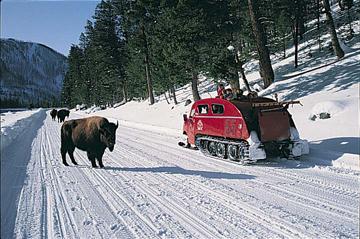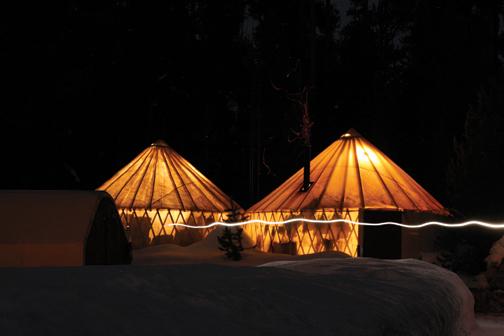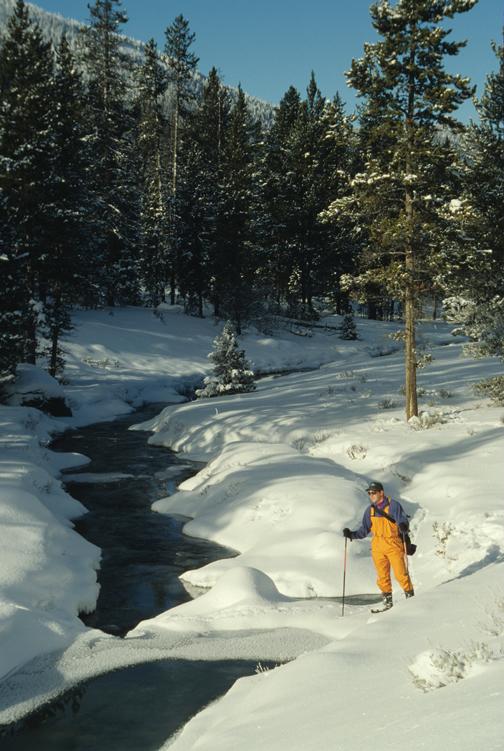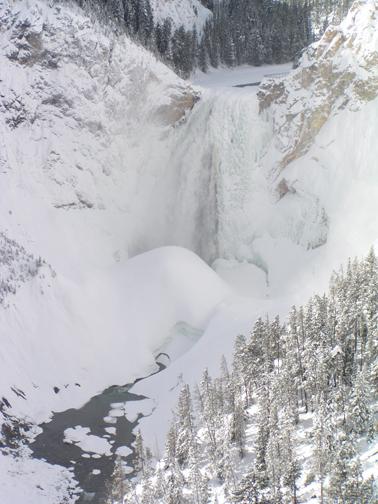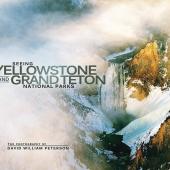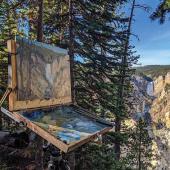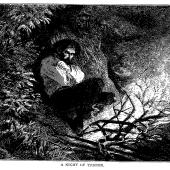A Yellowstone Winter
With three million people swarming its gates every year, Yellowstone can get a little crazy in the summertime. Not so in winter, when the endless human hordes are replaced by open roads, vast fields of white, and a cold, quiet beauty. There’s no shortage of activities in the off-season, just a dearth of visitors hardy enough to indulge them. If you don’t mind being cold and sacrificing a few creature comforts, you’ll be amply rewarded—with tranquility, solitude, and natural splendor. So, time to bundle up and head out! Here’s your Yellowstone to-do list for the winter season.
1) Check Out Tower Falls
by Mike England
From the parking area at Tower Junction, a mellow walk, ski, or snowshoe—depending on snowpack and one’s recreational predilections—weaves along a beautiful alpine drainage before sidehilling through dramatic cliffs of volcanic rock. After 2.3 miles, you’ll reach the Tower Falls overlook. Enjoy sweeping views of the mighty Yellowstone River far below, or venture down another half-mile to the base of the falls. In the winter, this dramatic 132-foot waterfall freezes layer upon layer until it reaches immense proportions, complete with massive ice-caverns built up below the base. Minarets or “towers” of rhyolitic basalt flank the falls on either side; hence the name of this majestic natural feature, assigned by the Washburn expedition in 1870. The descent into the Tower Creek gorge is steep and can be icy, so bring appropriate footwear and a set of mini-crampons. And don’t forget the camera—this is one winter scene you’ll want to look back on later, showing all your cold-phobic friends what they’re missing.
2) Strap on Snowshoes
by Ken Sinay
Snowshoeing has got to be the simplest and least controversial mode of transportation in Yellowstone. Of course, “slow shoes” as one friend of mine refers to them, are generally not embraced by adrenaline junkies, but if you like getting away from the “madding crowd,” snowshoes are a great way to go. If you can walk, you can snowshoe. It’s also less expensive to get geared up, and you don’t need a roof rack or trailer to transport them.
Outside the Park, local outdoor retailers in Livingston, West Yellowstone, Big Sky, and Bozeman have gear for rent. Inside the Park, Xanterra operates ski huts at Mammoth and Old Faithful that also rent snowshoes. On the west side, near West Yellowstone, there are great routes to the Madison River that take you to some remote landscapes, just outside town.
For big landscapes with big wildlife, enter Yellowstone from Gardiner and use the road from Mammoth to Cooke City. Being at a lower elevation than most of the Park, the snow may not be too good, but there are pockets of deep snow. The claw underneath most contemporary snowshoes can be helpful in icy conditions and the oversized shoe lends stability in areas pocked with ungulate postholes and feeding craters. Much of the rugged terrain in this area favors snowshoes for exploring.
The only logical way to access Old Faithful is via snowcoach or snowmobile from Mammoth or West Yellowstone. When you finally get there, you have access to the biggest geothermal area on the planet. But it’s not a landscape without some comforts. You can spend a night at Old Faithful Snow Lodge and enjoy a hot meal. The real treat is the snowshoeing along the Old Faithful trail system, or simply going to some backcountry thermal areas. Just be very careful if you go hot potting.
For those who desire more adventure, there are literally millions of acres of backcountry where no services are available, and I like it that way. Rely on yourself and forget the rest. Blaze your own trail. The northwest corner of Yellowstone, along Highway 191, provides a great jumping-off point to miles of good snow. If you do some research, you’ll find your own secret spots where you can quietly observe wildlife, hot springs, canyons, and serious winter.
3) Camp in a Yurt
by Peter Muennich
If backcountry adventure and more-than-comfortable camping is something you enjoy, a yurt might be the trip of a lifetime for you. Yellowstone Expeditions has two huge main yurts near the Grand Canyon of the Yellowstone that make up a cooking, dining, and social area. Yurts are circular rooms with wooden lattice frames and high dome-like ceilings. Originating in Asia, these nomadic dwellings are perfectly suited for Yellowstone’s winters.
My memorable drive with Erica into the Yellowstone Expeditions yurt camp from West Yellowstone included everything from wildlife sightings, to snow science lectures, to geological explanations of breathtaking scenery. Erica is a seasoned guide who works in the Park in both winter and summer, and the encyclopedia inside her brain is proof of her time spent here.
“Overall, it's important to offer a variety of experiences to people here in Yellowstone,” says owner Arden Bailey. His philosophy is a simple one: everyone has the same right to enjoy the Park in the winter as he does. Operating out of the same picture-perfect base camp since 1983, his company has witnessed the ongoing evolution of winter operations in our closest national park.
Our day of adventure included snowshoeing, cross-country skiing, and photography. Not having spent much time in the Park during the winter months, I was in awe of the crystal-white landscapes and wildlife. Exploring the Park on dead-quiet skis is incredible. A man that beams with enthusiasm and knowledge of his surroundings, Arden not only educated and entertained us, but also prepared an impressive steak dinner for everyone in camp.
Moonlight filled the small community of sleeping huts and yurts. I relaxed in my sleeping hut (a modified ice fishing hut with a surprisingly efficient furnace). The place was warm, and at 4am I scrambled for the bathroom under a moon brighter than any I had ever seen before. The cold air sank its teeth into my exposed torso and legs; luckily the bathhouse, though primitive in design, was the warmest structure in camp and contained several scented candles. Part of me wanted to stick out the rest of the night right there.
4) Free Your Heel
by Melynda Harrison
Kick up your heels and get your glide on. There are hundreds of great places to cross-country ski in and around Yellowstone, and many of them take you far off the beaten path so you can see the beauty of the Park without all the RV exhaust.
For instance, the North Rim Canyon trail is an easy 4.5-mile tour. The area can be quite crowded in summer, but this tour provides a great opportunity to view the Grand Canyon of the Yellowstone with relatively little company and access to many of the popular lookouts. Start at Canyon Warming Hut, but to get there, you’ll need to snowcoach or snowmobile in. Yellowstone Expeditions has a base camp at Canyon, from which you can explore all the trails in the area (yellowstoneexpeditions.com). Xanterra does Canyon tours from Old Faithful (yellowstonenationalparklodges.com).
The Spring Creek Trail is another option, though it’s a moderate-to-difficult route with some fast, steep downhill. It’s a lovely eight-mile tour that follows Spring Creek and then the Firehole River downhill from near the Continental Divide to the Old Faithful area. Start at the Old Faithful Snow Lodge and take the shuttle to the Spring Creek/Divide trailhead. If the distance intimidates you, ask the driver to drop you off early, cutting an hour or so off your skiing time. Xanterra offers lodging and transportation to Old Faithful.
If you want something even more challenging, try the Black Butte Creek to Daly Creek loop (5.9 miles with a car shuttle). This trail is a bit steep in places, but it’s a beautiful tour through lodgepole pines, aspens, Douglas firs, open meadows, and burned trees. You’ll need to leave a car at Daly Creek or hitchhike back to your vehicle at Black Butte Creek Trailhead. From Gallatin Gateway, drive south 53 miles on Hwy 191 (19.2 miles south of the Big Sky turnoff). Look for a parking area just south of the Black Butte Creek Trailhead on the east side of the highway.
Check travelyellowstone.com/daily-trail-status-1688.html for up-to-date trail conditions in Yellowstone.
5) Ride in a Snowcoach
by Phil Knight
A winter snow coach trip into Yellowstone is like no other journey on Earth. Snow may be six or eight feet deep. Bison stand like steaming sentries among the hot springs. Tracks of wolves, pine martens, and mice lace the snow. If conditions allow, you may be able to visit the Grand Canyon of the Yellowstone to see the falls cloaked in thick ice, Hayden Valley's vast meadows turned into an Arctic dream, or West Thumb Geyser Basin next to frozen-over Yellowstone Lake. Coach drivers provide interpretation, and will stop frequently to look for wildlife. You may see a fox diving head first into the snow in search of mice, or trumpeter swans patrolling the geothermal waters of the Firehole or Madison rivers. At Old Faithful, you can hop out of the snowcoach to cross-country ski on miles of groomed trails, walk the boardwalks among steam and snow-goblins, and cozy up in the Snow Lodge for drinks, dinner, and a warm bed.
There are many snowcoach tour operators to choose from. The majority operate four-wheel-drive vans converted for over-snow travel. Only two tour operators offer the original Bomabardier snowcoaches—my favorites by far. Yellowstone Alpen Guides (yellowstoneguides.com), operating from West Yellowstone, operates eight cherry-red Bombardiers, some dating back to 1953. Xanterra runs yellow Bomabardiers as well as van-type coaches, offering snow-coach service to and from all Park entrances. Other snowcoach operators include Yellowstone Vacations, All Yellowstone Sports, and See Yellowstone. For the full-immersion experience, you can arrange a several-day guided winter tour of Yellowstone through Yellowstone Association Institute or Off the Beaten Path.
6) Soak in the Boiling River
by Peter Muennich
Swimming outside in the middle of January can be more enjoyable than you might think. The Boiling River, a popular natural phenomenon, is only a few miles away from the Park’s north entrance at Gardiner, near Mammoth Hot Springs. A short half-mile riverside hike from the parking area brings you to one of the Park’s most relaxing natural wonders.
The Boiling River exists because thermal water travels underground from Mammoth before dumping into the ice-cold Gardiner River, creating a yin-yang of hot and cold that visitors can soak in. A normal day can draw a sizable crowd, but the winter months leave the river to only the bravest of aquatic enthusiasts. Although the river may seem like heaven on earth during a snowstorm, the walk back to your car can be both painful and damaging.
The 45th parallel is appropriately right down the road from the parking lot. Considering the drastic climatic differences between the North Pole and the equator, the boiling river could not have a more fitting home. Spring runoff turns the Gardiner River into a raging mud bath, closing the Boiling River for about two months.
Don’t forget a warm towel and your camera—both will come in handy. Check with the Park for unexpected closures by calling 307-344-7381.
7) Take Great Photos
by Mike Haring
With 99% of the tourists gone, winter is an exceptional time of the year to pack up the camera gear and head into the Park. Wildlife congregates in the valleys to escape the heavy mountain snowfalls, and sub-zero temperatures create a menagerie of landscape photo opportunities that rival any time of year.
Many operators offer snowmobile and snowcoach tours, which is a great way to get up close and personal with the area and its wildlife. If you want to drive yourself, take the road from Gardiner to Cooke City, which is open all year. This corridor is loaded with elk, bison, mule deer, coyote, and wolves. Use caution when driving this route, though, as many of the animals prefer to walk directly on the road as to slogging through four feet of snow.
The early hours of the day are often best, especially for scenic river shots. With sub-zero temperatures, the typical morning fog is transformed into ice crystals on the trees, shrubs and bushes that line the Park’s rivers, creating some truly ethereal photo opportunities. The unfrozen sections of Yellowstone’s rivers are also a great place to find wintering Trumpeter Swans, other waterfowl and the ever-present river otter, whom you might glimpse scampering across the ice from one hole to another.
Photographing subjects that are very bright (snow and ice) or very dark (moose and bison) can be a challenge. Most cameras are calibrated to an 18% grey, meaning that your camera’s built-in light meter will, when photographing snow for instance, underexpose the subject. When shooting something dark, like a moose, the image will be over exposed. If you’re using a film camera you’ll have to take this into account on most winter shots you take. If you’re shooting digital, don’t stress on it much. Today’s digital matrix metering systems are very advanced and do a bit of compensation for you. If you would still like to do some compensation, try metering a blue sky or green trees first then recompose and shoot your subject. This will give you a more accurate exposure no matter if your subject is light or dark.
Remember that Yellowstone is cold in winter, and whether you’re shooting from your vehicle, standing by the side of the road, or skiing/snow shoeing into the back country, the warmer you are, the longer you will be able to stay out in the elements to get that amazing shot. Wildlife photography takes patience and it’s extremely difficult to wait for something photo worthy to happen when you’re freezing to death—so dress warm.
8) Rent a Snowmobile
by Dave Reuss
While snowmobiling might be the most controversial form of transportation in Yellowstone, it’s definitely one of the most fun. Roaring along at speed across a wintery playground can bring a smile to the face of even the staunchest conservationist. Just remember to get into the Park, you’ll need a guided snowmobile tour from a licensed operator. The National Park Service only allows a predetermined amount of riders per day—318 at press time—on a first-come, first-served basis. Over-the-snow travel might be designated to trails only, but the trail system is expansive, looping over 200 miles through the Park and covers all the famous spots. A plan is being implemented to change the management of winter use in Yellowstone, so enjoy things while you can.
Outside the Park, there are plenty of events and thousands of miles of trail to explore in every direction, from Cooke City and its infamous Corn Fest celebrating the end of ski season, to Jackson Hole and its gnarly World Championship hill climb, to Island Park’s famous 33-mile-long “Main Street” constituting a snowmobiler’s paradise.
But if you want a guaranteed good time, make sure to check out the World Snowmobile Expo, March 11-13 in West Yellowstone. Capping off a year of Sno-Cross racing, this three-day extravaganza has it all: live music, professional riders, snowmobile freestyle and racing, new sled demos, and lots more. Snowmobile manufacturers and after-market companies show off their fancy 2011 stuff in the exposition hall with all the latest toys on shiny new sleds.
9) Stay Over at Old Faithful
by Melynda Harrison
Built around the iconic Yellowstone geyser, the Old Faithful area is home to wintering wildlife, a thermally heated river, three geyser basins (Upper, Middle and Lower), several hotels (one of which is open in the winter), and great cross-country skiing. While it might be expensive to get to and stay at Old Faithful, the experience of being in the middle of a winter wonderland makes it worth the price. You can drive as close as West Yellowstone at the west entrance or Mammoth at the north entrance; from there, a snowcoach or snowmobile is necessary to access Old Faithful. Just remember that all over-snow vehicle travel must be with a permitted guide. Check the Park’s website for more info.
Bison and elk live here year round, taking advantage of the warm ground and thin snow around the many thermal features. Wolf and coyote tracks are often spotted just off the boardwalk. And of course, Old Faithful itself erupts constantly for your viewing pleasure. The steam rising off in winter makes it even more of a treat.
To stay at the Old Faithful Snow Lodge, log onto travelyellowstone.com. They’ll want to know how you are getting there, so be sure to check into snowcoach reservations as well. If you plan on entering by a Xanterra coach, the lodging reservations folks should be able to help you.
Four ski shuttles leave from the Snow Lodge daily. They depart hourly from 8am-11am and destination depends on the first person to sign up—either northwest to Fairy Falls or east to Spring Creek / Divide Trail. You can sign up for a shuttle (and determine its drop-off point) well in advance. If you don’t care where the shuttle goes, sign up as soon as possible to guarantee a seat with Bear Den Ski Shop at 307-545-4825. Xanterra also runs day tours to Canyon from the Snow Lodge. These trips include great skiing, an interpretive guide, and lunch. Some XC trails are machine groomed, while others are skier tracked. Check travelyellowstone.com for up-to-date trail conditions.
10) Climb a Frozen Waterfall
by Dave Reuss
To the climber in Yellowstone, all those beautiful waterfalls around the park mean one thing—a vast playground of waterfall ice. The Park has it all: wildlife, scenery, tons of routes, and hot springs to relax in after a hard day on the ice. A far cry from Hyalite in our backyard, crowds are scarce and adventure is guaranteed. One thing to factor in is that the Park is massive and takes a lot of time to get around: allot at least two hours to get from Livingston to Cooke City. Remember that the park entrance fee is $25 for a 7-day pass (at press time), road access might be an issue, and bolting is strictly prohibited. And when in the Park, observe the speed limit or you will get pulled over (I’ve been snagged twice). As with all ice climbing, always use extreme caution—a late-season attempt on the Grand Canyon of the Yellowstone last spring resulted in the death of two experienced Bozeman climbers. For a great guide detailing the area, make sure to pick up Big Sky Ice by Ron Brunckhorst—he’s got about 30 pages intricately covering the best climbs in the area.
11) Watch Wild Wolves
by Phil Knight
Wild wolves were missing from Yellowstone for over 65 years. Reintroduced in 1995, Yellowstone’s wolf population is at about 130 now. This summer was a good one for wolf pup survival, and most of the 11 packs in the Park have youngsters. This year the most visible wolf packs were the Lamar Canyon Pack in the Slough Creek and Lamar Valley area, the Silver Pack (also in Lamar), and the Canyon Pack in Hayden Valley. The Silver Pack is now hard to see, and Hayden Valley is more difficult to access in winter (a snowcoach or snowmobile trip is required).
Winter is the easiest time to spot Canis lupus. The best way to get an in-depth look at wolves and their behavior, history, ecology, and politics is a Yellowstone Association Institute class (yellowstoneassociation.org/institute). You'll explore Yellowstone's Northern Range with an expert and have the option to stay at the Lamar Buffalo Ranch in the heart of wolf country. You can also take a winter tour with Bozeman-based Yellowstone Safari Company (yellowstonesafaricompany.com), which will drive you to and from the Park and provide full guide service. Unless you're planning an extended winter tour of the Park (which I do recommend; try offthebeatenpath.com), Lamar Valley and nearby Slough Creek are the best areas to spot wolves.
If you want to watch wolves on your own, drive into Yellowstone's Lamar Valley or Slough Creek. The road is open all year. Find an overlook and take some time to look and listen. Bring your binoculars to search for wolves and a spotting scope to watch them. It’s a three-hour drive from Bozeman, so consider overnighting in Silver Gate (pineedgecabins.com) or in Gardiner. Your best bet to catch wolves in action is at dawn. Plan on at least one early start.
The National Park Service requires you to stay at least 25 yards from all large wild animals. However, that is way too close for a wolf. If you are obviously affecting the behavior of the animal, it's time to leave. That's what scopes and long camera lenses are for. Stay in or near your car if wolves are close.
12) Take a Class at YAI
by Amy McMahon
On the same conservation bent, the Yellowstone Association Institute (YAI), a nonprofit association offering educational products and services for Yellowstone National Park, has raised over $24 million for the Park since 1933. YAI offers a variety of classes, from tracking to nature writing to wildlife watching, and its modest cabins are little slices of heaven—and a step above camping, with new showers on site—that only Yellowstone can provide. Head to the middle of the Lamar Valley for some cabin therapy and spend time in nature. The YAI enables Americans from all over to link to their environment, as evidenced by the class I visited during March of 2010. Members of my writing class came from as far as North Carolina and from as close as Yellowstone itself. For more information on available classes, dates, and membership, visit yellowstoneassociation.com/institute.
13) Spend a Weekend in West Yellowstone
by Sara Hoovler and Jan Stoddard
In the winter wonderland of West Yellowstone, snowfall averages 143 inches, starting in November and lasting through mid-April. The streets of West Yellowstone remain snow-packed all season, providing a trailhead literally at your front door. Ski or snowmobile from your hotel or motel to an extensive trail system. Snowmobile rentals (including clothing) are available for different skill levels. A 400-mile groomed trail system winds through the southern reaches of Montana and into Island Park, Idaho. For the experienced skier or snowmobiler, groomed trails lead to back country adventures. Professional guides are available to take enthusiasts to remote locations with untracked powder and no lines.
West Yellowstone is also a cross-country skier’s paradise. Snow-covered trails, perfect corduroy, and rolling terrain entice everyone from diehards to neophytes. The groomed Rendezvous Ski Trails, at the southwestern edge of town, offer over 35 kilometers of varied terrain from gently rolling hills to more challenging climbs. The "Upriver" and "Downriver" loops of the Riverside Trail combine for nearly ten kilometers of classic track along the banks of the Madison River. Dogs, classic skiers, and snowshoers are welcome on the Boundary Trail, a six-mile out-and-back from town to Baker’s Hole Campground. Just north of West Yellowstone lies some of the best, low-angle backcountry skiing in the West. Trailheads along Highway 191 provide easy access to incredible scenery, petrified trees, and winter wildlife.
Bring the kids, as family fun abounds. The Grizzly & Wolf Discovery Center is open year round (these grizzlies don’t hibernate) and offers kid-friendly activities and presentations. The neighboring IMAX theater offers large-screen movies, while weekly presentations by Yellowstone Park rangers can be found right in West Yellowstone. The local skating rink is open to the public and rentals are available.
Winter brings a variety of events to West Yellowstone. S’mores & Skating events are held monthly throughout the winter. Join locals and visitors at the community ice rink and enjoy everyone’s favorite dessert. A Kids ’n’ Snow weekend is planned for December 17-18, where kids learn to have fun outside in the winter. The Spam Cup returns on December 18, January 9, and February 12. These citizen ski races are open to every age and racing ability. Winners take home the highly coveted SPAM can trophies.
With the boom of a black powder cannon, hundreds of skiers set off on the annual Yellowstone Rendezvous Race, the area’s only marathon cross-country ski race. Test yourself on the 50k, 25k, and 10k course on March 5, 2011. Make it a weekend and bring your camera for the Youth Ski Festival on March 6. Young skiers compete in light-hearted events like musical chairs, relay races, and the obstacle course.
The World Snowmobile Expo culminates a year of Sno-Cross racing with three days of racing thrills, the popular Freestyle Aerial demo, and evening fun from March 11-13. Or, wind down the winter at the Equinox Ski Challenge on March 19-20.
West Yellowstone offers everything from snowshoe or ski rentals and lessons, to tours and guides. For more information, call the West Yellowstone Chamber at 406-646-7701 or visit destinationyellowstone.com. For more info on cross-country events, go to rendezvousskitrails.com.

